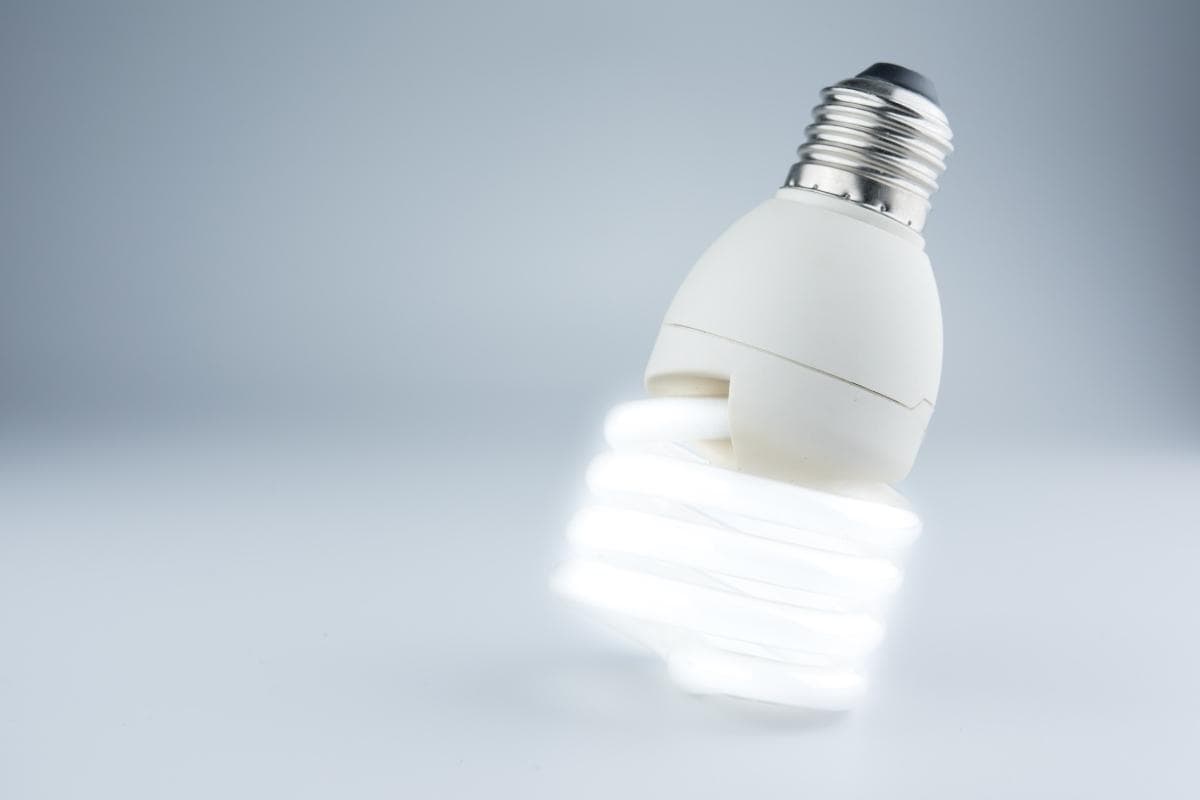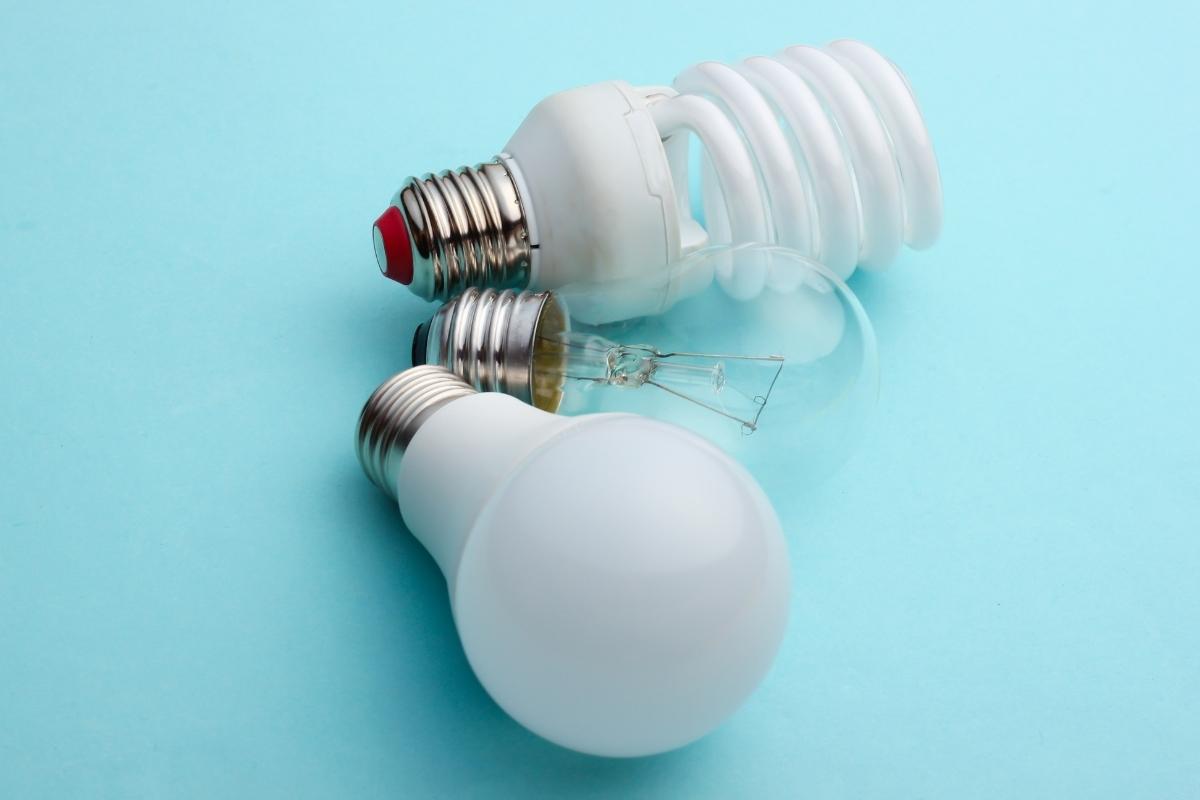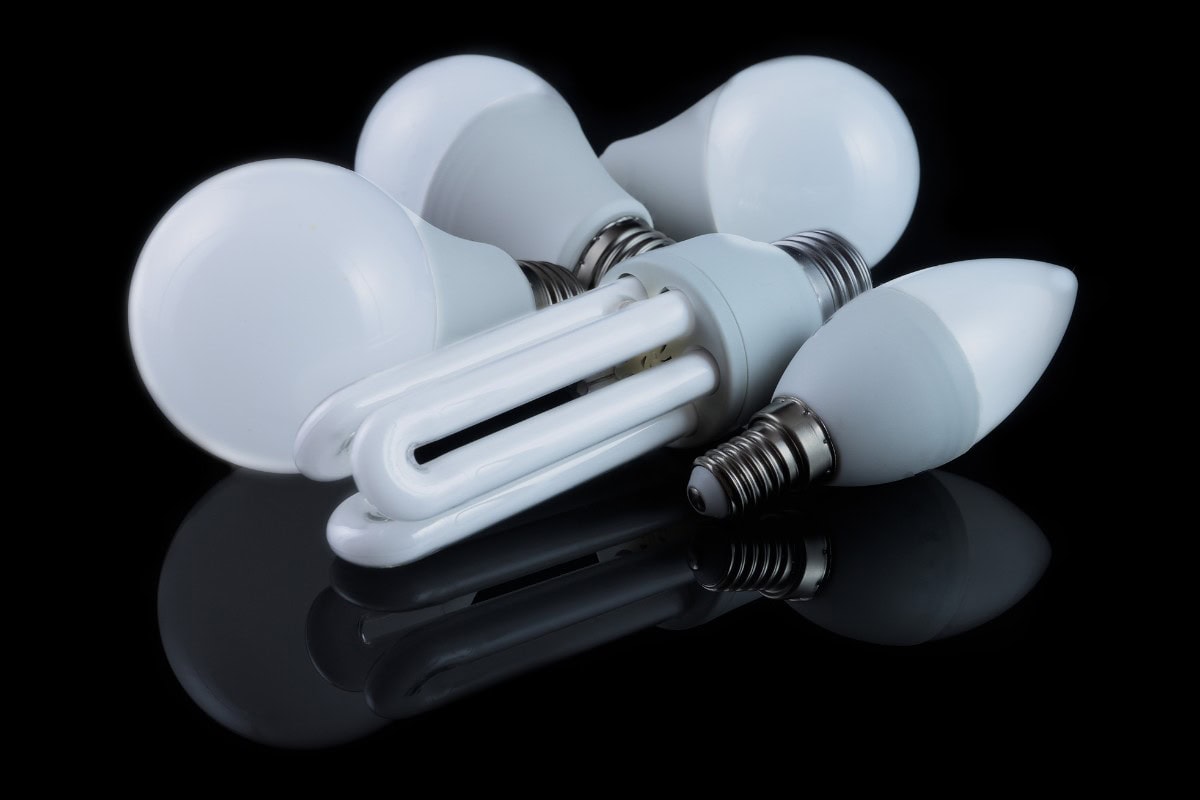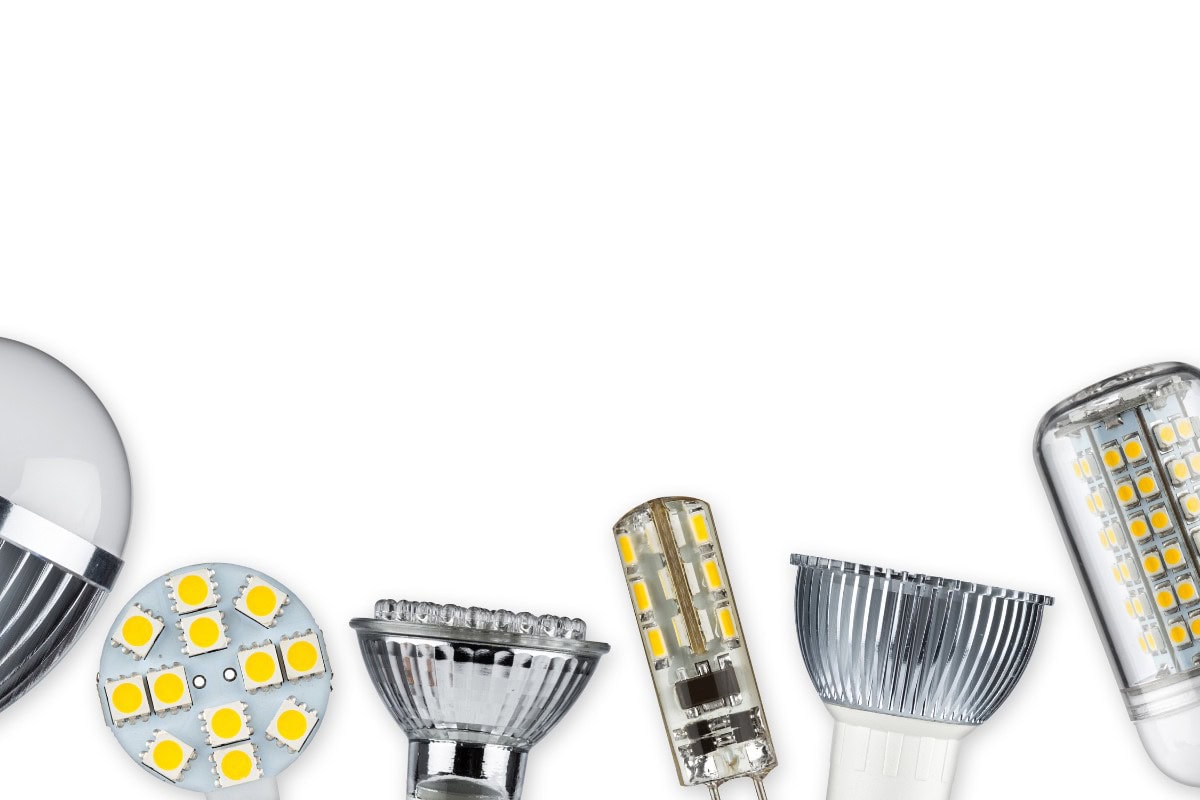Back in the day, when there was only one type of incandescent bulb, it was fairly easy to tell how bright a light bulb was. The only metric ever mentioned about light bulbs is the watts. The higher wattage of a light bulb, the brighter it looks. A 60W bulb is without question brighter than a 40W bulb. It just makes sense because it consumes more energy and it ought to produce more light.
With new energy-efficient bulbs such as CFL and LED bulbs introduced, comparing the brightness by their watts no longer works. A 10W LED bulb can have the same brightness as a 60W incandescent bulb. It can be difficult to replace a traditional incandescent bulb with an LED bulb without knowing how to read and compare the brightness of each type of bulb.
Now it’s time to learn about lumens, the actual term that is used to measure the brightness of a light source and how much light it can output.
What Are Lumens
Lumens measure the brightness of a light source or how much light it outputs. The higher lumens, the brighter the light source looks to human eyes. The fewer lumens, the dimmer the light source looks.
The lumen(lm) is the unit of luminous flux(light output), which is a measure of the total quantity of visible light that human eyes can detect emitted by a light source. If a light source emits one candela of luminous intensity uniformly across a solid angle of one steradian, the total luminous flux emitted into that angle is one lumen.
ANSI Lumens
ANSI lumens are the light output of projectors measured under the standard established by the American National Standards Institute, thus the name ANSI lumens. ANSI lumen measurements are generally more accurate than other lumens measurement methods used in the projector industry.
Useful Lumens
Useful lumens measure the light output emitted within a 90-degree cone. They are mostly used to measure directional lights such as spotlights which we only need the light projected in a certain direction. Useful lumens are lower than total lumens because the light outside the 90-degree cone is treated as waste light and ignored because it’s not useful to illuminate the target area we want.
Why Use Lumens Over Watts
Back in the days when incandescent and halogen lights were the primary light source, the brightness was measured in watts. Though watts are the measurement for power, which is a different thing from brightness, most consumer incandescent bulbs have the same energy efficiency, which means they produce the same amount of lumens per watt. So the more power they consume, the brighter the light output is. In other words, the more watts, the more lumens. Though it’s not accurate to associate watts with brightness, watts can still give you a good idea about the brightness of the bulb.
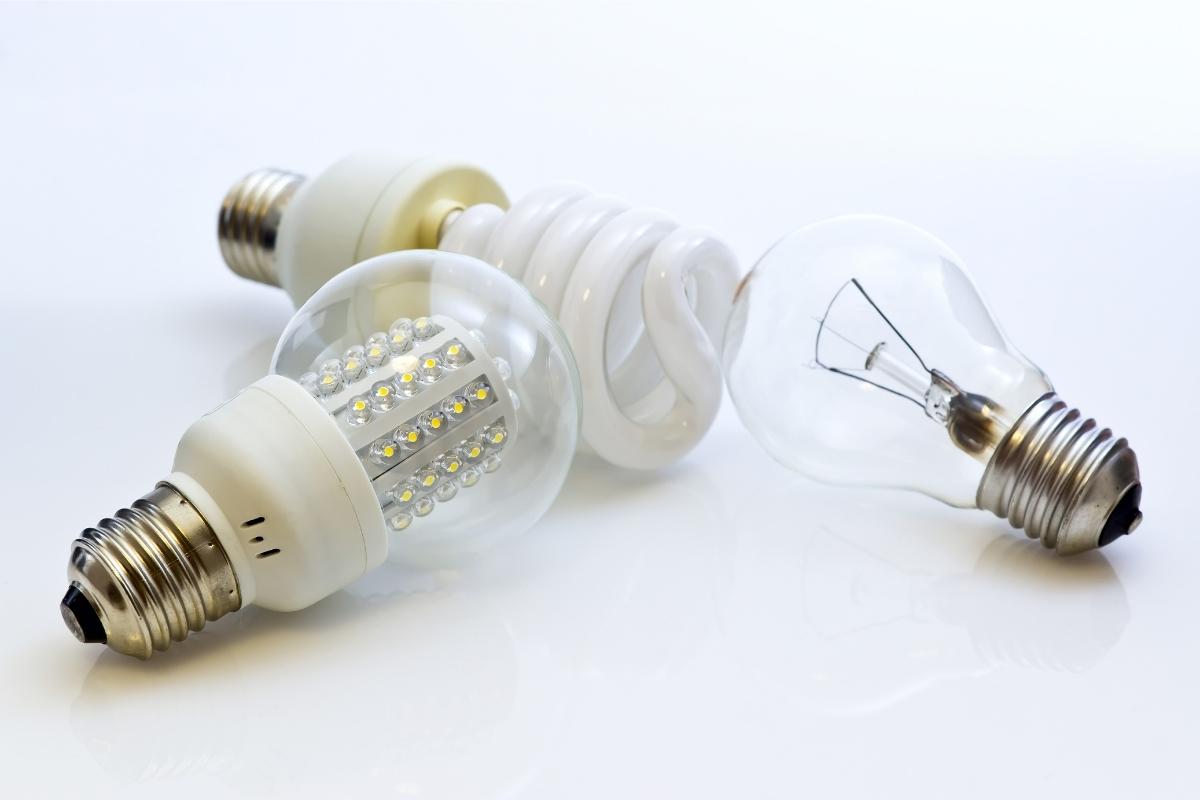
As technology develops, new energy-efficient bulbs such as CFL and LED bulbs with high energy efficiency can consume much less power to produce the same level of light output. They produce light in a more efficient way that they do not need to convert energy to heat first, then to light the way traditional incandescent bulb works. Without much energy wasted as heat rather than light, a 15W LED can output the same 1600 lumens brightness as a 100W incandescent bulb. It is no longer proper to use wattage to compare the brightness of bulbs from different light sources. Not to mention that wattage is by default measurement for power, never meant to describe how much light it can produce.
The best and most accurate way to measure the brightness across all types of bulbs is to look at lumens, not watts. Any light sources with the same lumens should have the same brightness and output the same amount of light. Now you can easily switch one of your 1600 lumens bulb with either an incandescent, halogen, CFL or LED bulb with the same 1600 lumens without affecting the brightness or illuminance of your room.
If you have an old incandescent bulb and don’t know its lumens, there is still a way to replace it. Light bulb manufacturers may also specify the equivalent standard wattage on the package for users to easily compare the brightness of the bulb with incandescent bulbs, such as 100W Equivalent or 60W Replacement. If you see a 10W led bulb labeled 60W equivalent, it should have the same or similar lumens as a 60w incandescent bulb. You won’t notice any significant differences in the light output.
Luminous Efficacy (Lumens per Watt)
Luminous efficacy is a measure of how well a light source emits visible light at a given power commonly used in the lighting industry. It is the ratio of luminous flux to power, measured in lumens per watt(lm/W). However, in many situations, the term “luminous efficiency” is often misused to substitute for “luminous efficacy”, which are indeed two different measurements. When talking about lighting efficiency, it’s common to see that both terms are used to describe lumens per watt. Most of the time, we just call it lumens per watt for its simplicity and self-explanatory.
Higher lumens per watt value means the light source is more energy efficient as more light is produced using less power. Lower lumens per watt value means the light source is less energy efficient as less light is produced using more power.
Lumens per watt is very useful when selecting light bulbs. You can calculate how efficient a bulb is by simply dividing the number of lumens by the number of watts. You should select a range of bulbs with the lumens you need first and then pick the one with the lowest watts for saving energy. That said, you want high lumens with low watts.
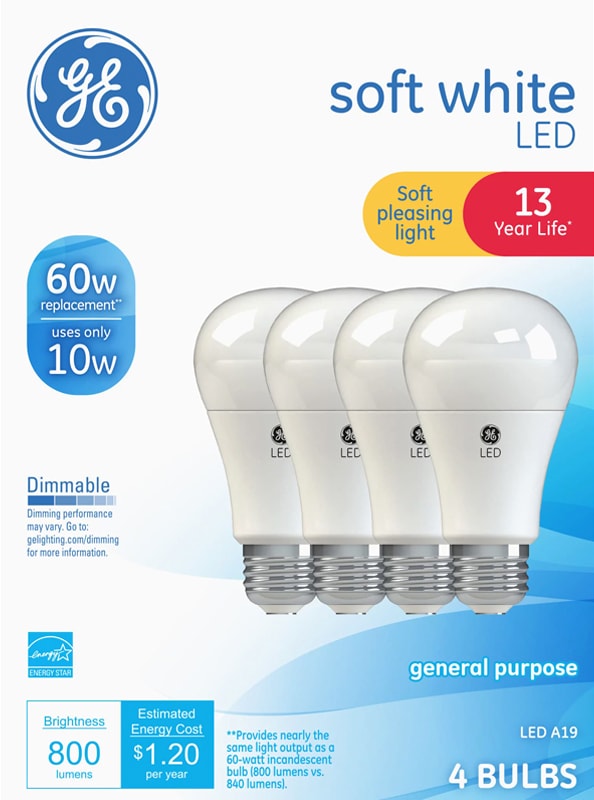
Many LED bulbs will also label two watts on the package. One is the actual wattage or initial wattage it consumes, and one is the equivalent watts of standard incandescent bulbs. Use the actual wattage when measuring its lighting efficiency.
Note that as technology improves and design varies between manufacturers, the same type of bulb may have quite different lighting efficiencies. For the same 750 lumens LED bulb, you may get 6W, 9W to 10W bulbs on the market, provided by various brands.
Lumens to Watts Conversion
We have provided a lumen chart to help you easily convert lumens to watts and compare equivalent wattage between incandescent, halogen, CFL and LED bulbs with the same lumens. This chart can be very helpful when replacing your current bulb with any other bulb without affecting the existing brightness.
We strive to make the lumens to watts conversion chart as accurate and universal as possible by researching hundreds of bulbs currently sold on amazon. As different bulbs have various lighting efficiency, the actual watts or light output may vary by product. This comparison table is up to date and can be used for a brief reference.
Lumens to Watts Conversion Chart
| Lumens(lm) | Incandescent(W) | Halogen(W) | CFL(W) | LED(W) |
|---|---|---|---|---|
| 450 | 40 | 29 – 35 | 7 – 11 | 3 – 5.5 |
| 800 | 60 | 50 – 53 | 13 – 15 | 8 – 12 |
| 1100 | 75 | 60 – 75 | 18 – 26 | 9 – 15 |
| 1600 | 100 | 80 – 100 | 23 – 28 | 12 – 17 |
| 2600 | 150 | 150 | 40 – 42 | 19 – 24 |
For example, we can see that a 60 watts bulb outputs 800 lumens, equal to the light output from an 8-12W LED light and a 100 watts bulb has 1600 lumens, equal to the light output from a 12-17W LED light.
Lighting Facts Label
The FTC requires light manufacturers to include a lighting facts label with key information in an easy-to-read format to help consumers shop for energy-efficient bulbs. When buying a light bulb for certain lumens or color temperature, you should first look at the lighting facts label on the package of the light.
Since it’s made easy to read, most of the facts are self-explanatory.
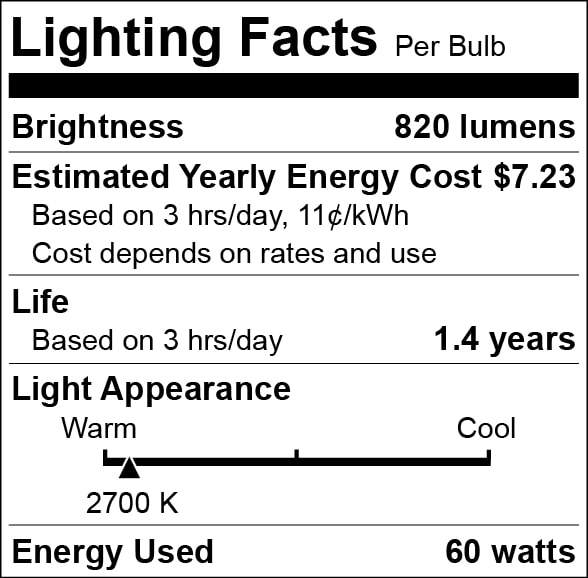
The light appearance is the correlated color temperature of the bulb, measured in Kelvin. The 2700K is its color temperature value. The smaller the value, the warmer and the more yellow the light appears. The larger the value, the cooler and the bluer the light appears.
The energy used is the initial wattage of the bulb. It’s the power that the bulb actually consumes, not the equivalent wattage.
Manufacturers who have a signed Memorandum of Understanding with the Department of Energy or the Environmental Protection Agency may add the ENERGY STAR logo to labels. It’s recommended to choose Energy Star certified products for energy efficiency.
The design voltage of each lamp is 120 volts by default. If it’s not 120V, it will be specified and included in the package.
Lumens vs Lux
Lux is the unit of illuminance that measures how much luminous flux (lumens) per unit area. To calculate lux, divide the number of lumens by the size of the area in square meters, so one lux is equal to one lumen per square meter. You can think of luminous flux(lumens) as the total amount of visible light, but lumens do not tell you how bright or dim the light is when spread on the surface. When the same amount of light(lumens) illuminates a small area, the surface of that area looks brighter. When the same amount of light illuminates a larger area, the surface of that area looks dim. Illuminance(lux) is a measure of the intensity of illumination on the surface.
Knowing the difference between lumens and lux is very important for lighting design. Lumens are used to compare the brightness between two light sources. For example, a 1600 lumens bulb is brighter than a 800 lumens bulb. Lux is used to describe how bright the surface is under the light source. For example, it’s recommended to have at least 100 lux for your living room for minimal visibility. If your living room is 30 square meters, you need a total of 3000 lumens with all bulbs combined. If your living room is 20 square meters, you need a total of 2000 lumens with all bulbs combined.
Lumens vs Foot Candles
Foot-candle(fc) is a unit of illuminance or light intensity, defined as the illuminance of one lumen on a one square foot surface with a uniform distribution. So one foot-candle is one lumen per square foot. Foot-candle is similar to lux(lumen per square meter) except that they use the unit foot instead of meter. As 1 foot is 0.3048 meters, 1 foot-candle is 10.76 lux and 1 lux is 0.09 foot-candle. It’s very convenient to calculate foot candles to lux and vice versa.
The unit foot-candle is mainly used in the US whereas the rest of the world mostly uses the term lux. In modern usage, lumens per square foot is widely used to substitute for foot candles because it’s much easier to understand and self-explanatory for end customers.
In the US lighting industry, foot candles are a common unit of measurement used by architects and designers to calculate sufficient lighting levels to ensure every space has proper lighting. For example, designers often recommend 10-20 foot candles in the bedroom for adequate illuminance. If your bedroom is 100 square feet, you may need 1000-2000 lumens of light in total in the bedroom for proper lighting.
Calculating lumens per square foot is very simple. Calculate the square footage of a room by measuring the width and the length of the room and then multiply the numbers. Add up the lumens of all light bulbs in the room as the total lumens and then divide by the square footage of the room to get the lumens per square foot number.
Lumens vs Candlepower
Candlepower(cp) is a unit of measurement for luminous intensity. It expresses levels of light intensity relative to the light emitted by a candle of specific size and constituents and is sometimes used as a synonym for candela. Candlepower measures the intensity of the light on a target rather than the total amount of light it emits.
Candlepower is now largely an obsolete term but is still being used to describe the luminous intensity of narrow-beamed light sources, such as flashlights and spotlights, that emits light in a particular direction. The value of candlepower increases when the light is more focused. When comparing brightness, look for lumens when you need a light to illuminate a room and look for candlepower when you need an intense beam.
Though lumen and candlepower are two different things, it’s still possible to convert lumens to candlepower. From the definition of lumens – If a light source emits one candela of luminous intensity uniformly across a solid angle of one steradian, the total luminous flux emitted into that angle is one lumen (1 cd·1 sr = 1 lm). Alternatively, an isotropic one-candela light source emits a total luminous flux of exactly 4π lumens. Because candela equates 1:1 to candlepower, one candlepower is 4π lumens, which is approximately 12.57 lumens.
Lumens vs Kelvin
Kelvin(K) unit refers to the color temperature of a light source. In lighting industry, the correlated color temperature is used to describe the color or hue of the light, which is often shortened as color temperature. The lower the color temperature, the warmer and more orange and yellow the light looks to human eyes. The higher the color temperature, the cooler and more white and blue the light looks to human eyes.
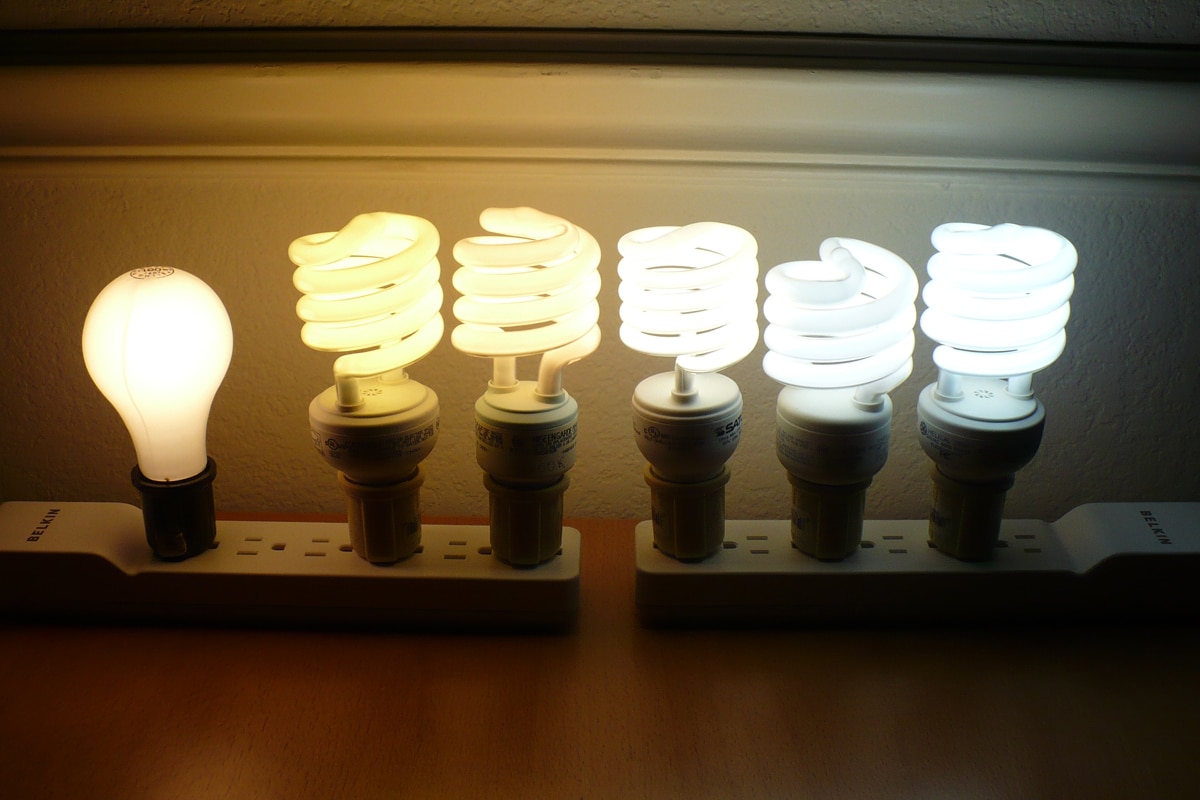
Lumens measure brightness and kelvin measures color temperature. They are two different things and cannot convert with each other. For example, a warm color temperature light can be either bright or dim when used with a dimmer switch.
How Many Lumens Do I Need
Lumens are particularly useful when planning lighting design and deciding how bright you want for your room. How many lumens you need for your room is a personal preference and can depend on many factors. The size, height and shape of the room, the purpose of the room, and whether you need general or task lighting can all have an impact on the lumens you need.
This table shows the lumens you need for each room. The lumens and foot-candle are all minimal requirements for proper visibility. 1 foot-candle is equivalent to 10 lux in this table.
| Room | Foot-candle(fc) | Lux(lx) | Lumens(lm) | Average Size(sq. ft) |
|---|---|---|---|---|
| Hallway | 5 – 10 | 50 – 100 | 500 – 1000 | 100 |
| Living Room | 10 – 20 | 100 – 200 | 3400 – 6800 | 340 |
| Bedroom | 10 – 20 | 100 – 200 | 1320 – 2640 | 132 |
| Dining Room | 30 – 40 | 300 – 400 | 6720 – 8960 | 224 |
| Kitchen | 30 – 40 | 300 – 400 | 7140 – 9520 | 238 |
| Bathroom | 70 – 80 | 700 – 800 | 7000 – 8000 | 100 |
| Kitchen Work Areas | 70 – 80 | 700 – 800 | 2100 – 2400 | 30 |

